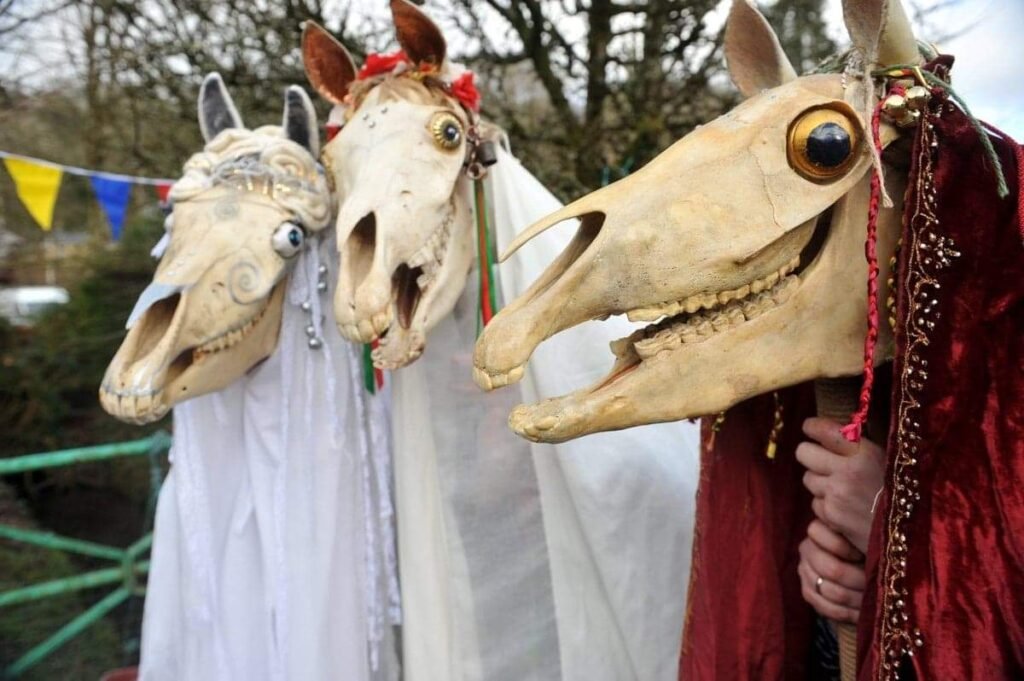As the world turned toward a new year, it’s time for a captivating journey across time and traditions. From Scotland’s misty highlands to Romania’s vibrant streets, from Japan’s solemn temples to Chile’s mysterious graveyards, we’ll explore diverse New Year’s customs. These aren’t mere traditions. They echo centuries past, speaking of superstitions, celebrations, and the eternal dance between life and death.
The Dark Rider of Scotland
The First-Footing Tradition

In the heart of Scotland, as the old year gives way to the new, a unique and suspenseful tradition unfolds. First-Footing. Rooted in Scottish, Northern English, and Manx folklore, this custom dictates that the first person to enter a home after the stroke of midnight on New Year’s Day will bring either good fortune or misfortune for the year ahead. The ideal “first-footer” is often a tall, dark-haired male, believed to bring the best luck. This figure, stepping into the house at the very start of the year, is laden with symbolism and expectation.
Origins of First-Footing: Tracing the Threads of Tradition
The roots of First-Footing are shrouded in mystery, with some tracing it back to the Viking invasions of the British Isles. A stranger’s arrival, especially a dark-haired one, once stirred fear, reminiscent of the alarming days of Viking raids. This tradition has evolved over time, intertwining with local customs and superstitions.
In Scotland, the practice varies from place to place, but it generally involves the first-footer bringing symbolic gifts such as coal, coins, whisky, or black buns. These gifts are not just tokens of goodwill but also emblems of warmth, prosperity, and celebration. In return, the first-footer is often greeted with food and drink, marking a communal start to the New Year.
The Intricacies of First-Footing in Scottish Culture and Beyond
Interestingly, the tradition of First-Footing is not exclusive to Scotland. Greek, Vietnamese, and Georgian New Year traditions feature similar practices, each with its unique cultural spin. However, in Scotland, this practice takes on a distinct elaboration, tightly woven into Hogmanay celebrations. It mirrors the nation’s diverse cultural fabric and its enduring allure for the mystical and the unknown.
Japan’s Bell of Forgetfulness
Joya no Kane
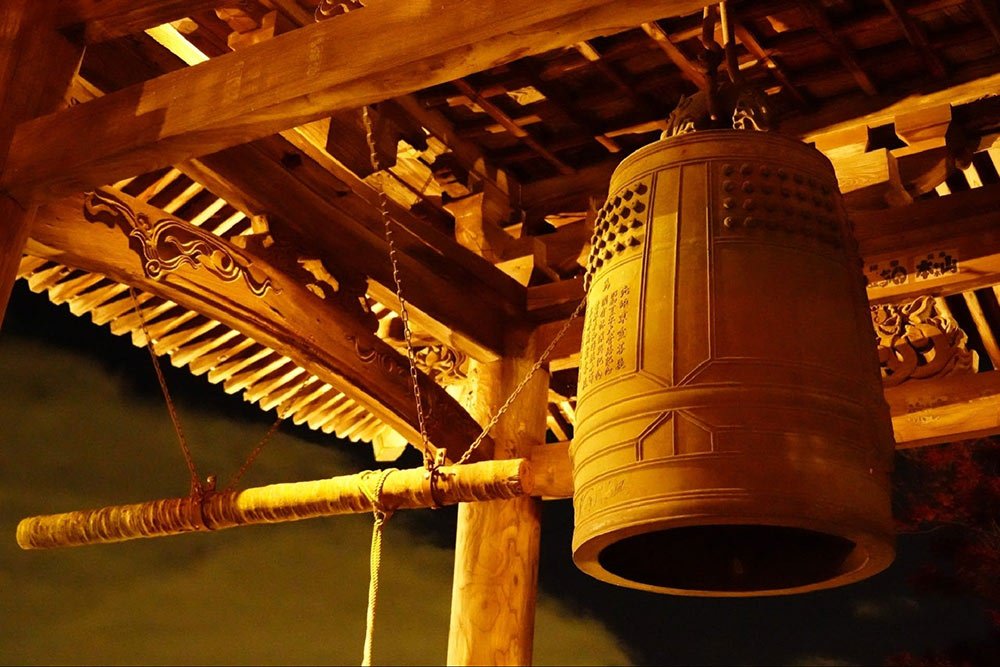
As the New Year approaches in Japan, a profound and resonant tradition takes place: Joya no Kane. This ritual, deeply rooted in Japanese Buddhist customs, is observed on New Year’s Eve as part of the Ōmisoka celebrations. The heart of this tradition lies in the striking of the temple bell, or bonshō, 108 times at midnight. This practice, primarily celebrated in Japan but also observed in South Korea and at Japanese Buddhist temples worldwide, symbolizes the purification of the soul.
Unveiling the Origins of Joya no Kane
The origin of Joya no Kane can be traced back to Zen Buddhist customs from the Song dynasty in China, adopted by Japanese Zen temples during the Kamakura period. The ritual of ringing the bell 108 times is steeped in Buddhist philosophy. In Buddhism, it is believed that humans have 108 sins or kleshas. These are derived from the six senses – sight, hearing, smell, taste, body, and mind – each with pleasant, unpleasant, and neutral variations, further divided into pure and impure categories. These variations, multiplied by the three aspects of time – past, present, and future – result in the 108 kleshas.
Soulful Reverberations: The Cultural Significance of Joya no Kane in Japan
Ringing the bell 108 times signifies purging these 108 sins, cleansing the soul for the year ahead. Some temples, especially those welcoming laypeople, might ring beyond 108 times, often in multiples of 108 or reaching upwards of 200 or more. This ritual, originating from Zen Buddhism, gained immense traction in Japan during the Showa Period, notably through radio broadcasts.
Joya no Kane goes beyond religious observation. It embodies Japan’s cultural reverence for tradition, marking a reflective embrace of the New Year. The echoing bells in the cold night beckon introspection, providing a tranquil pause for spiritual cleansing amidst the New Year’s revelries.
The Ghostly Processions of Wales
Mari Lwyd
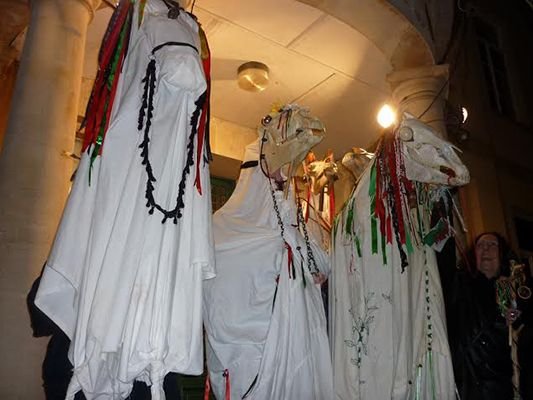
In the wintry landscapes of South Wales, a haunting and enigmatic tradition known as Mari Lwyd (Y Fari Lwyd) is observed. This wassailing folk custom, deeply rooted in Welsh culture, involves a peculiar and evil figure. A hobby horse made from a horse’s skull mounted on a pole, shrouded in a white sheet, and carried by an individual concealed beneath sackcloth. The Mari Lwyd is a striking and ghostly presence, embodying a blend of festivity and macabre.
A Welsh Spectral Legacy
First recorded in 1800, the Mari Lwyd was traditionally performed around Christmas and New Year. Groups of men, often including characters like Punch and Judy, would accompany the Mari Lwyd from house to house, engaging in a unique form of musical battle known as pwnco. They would request entry through song, and the householders would respond in kind, denying them entry. This exchange of verses would continue until the householders relented, allowing the group inside for food and drink.
The etymology of “Mari Lwyd” is a subject of debate. Some think it means “Holy Mary,” tied to Jesus’ mother, while others lean toward “Grey Mare,” describing the horse’s look. Despite early notions of pre-Christian roots, recent research leans towards it as a localized spread of hobby horses among the elite during the sixteenth and seventeenth centuries, lacking supporting evidence for its earlier origins.
The Mari Lwyd itself is a captivating sight. The horse’s skull, often able to open and close its jaw through strings or levers, is adorned with ribbons and sometimes features glass in the eye sockets. The preparation of the Mari Lwyd was a communal event, involving many locals in its decoration.
The Revival and Mystique of Mari Lwyd in Wales
Performed during winter festivities, the custom varied in date and duration between villages. The Mari Lwyd party, adorned with colored ribbons and rosettes, would bring a blend of fear and amusement. Inside the houses, the Mari Lwyd would create chaos, snapping its jaws and neighing, while the group entertained the householders with music and merriment.
In the early to mid-twentieth century, this tradition waned, facing resistance from local Christian clergy and shifts in society. However, in recent times, it’s experienced a resurgence. The Mari Lwyd endures as a potent emblem of Welsh cultural legacy that still fascinates and entices.
Spain’s Witching Grapes
The Twelve Grapes of Luck
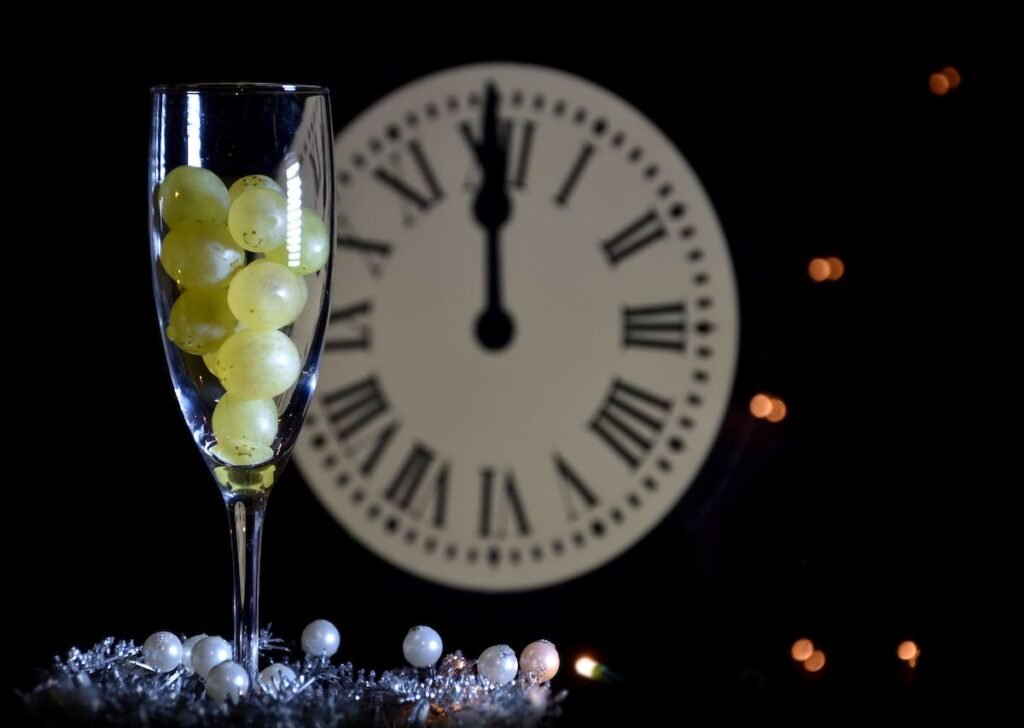
In Spain, as midnight on December 31st approaches, a vibrant tradition unfolds: the Twelve Grapes of Luck. Embedded in Spanish culture, it entails eating a grape with each chime of the clock at midnight, symbolizing the New Year’s welcome. Each grape signifies a forthcoming month, believed to bring good luck and prosperity for the year ahead.
Spanning Cultures in the Celebration of New Year’s Eve
The origin of this tradition dates back to at least 1895 and became widespread in 1909. In that year, Alicantese vine growers popularized the custom as a means to sell an excess of grapes from a bountiful harvest. Over time, the tradition evolved beyond its commercial roots to become a staple of Spanish New Year’s celebrations. Today, it primarily serves as a festive practice to celebrate the New Year.
The Evolution of Spain’s Twelve Grapes of Luck”
Spaniards embrace this tradition in two settings: at home post-Nochevieja dinner or in public squares, notably Puerta del Sol in Madrid—the tradition’s birthplace. The Royal House of the Post Office’s clock signals the Twelve Grapes’ consumption, broadcast nationwide on TV and radio.
This tradition extends its reach beyond Spain, echoing through cultures with strong ties to Spanish and Latin American roots, including Hispanic communities globally, notably in the United States. As a key element of Hispanic Christmas festivities, the Twelve Grapes of Luck symbolize hope, renewal, and the shared aspiration for a prosperous year ahead.
Romania’s Bear Dance
A Vibrant New Year Tradition
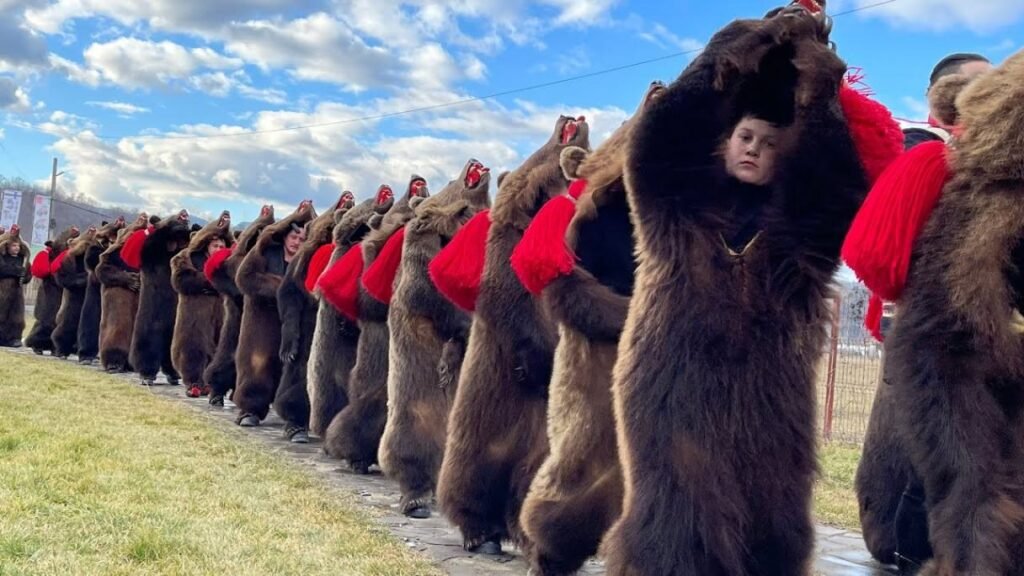
In Romania, the Bear Dance is a captivating and colorful tradition that marks the New Year celebrations. The country’s folklore and cultural heritage deeply root this unique custom. The Bear Dance isn’t just a winter performance. It’s a symbolic ritual embodying the cycle of time, signifying both death and rebirth. Believed to purify and enrich the soil for the upcoming year, it holds a deeper significance beyond mere dance.
Bear Dance: Romania’s Ancient Rite of Renewal and Celebration
The performers, dressed in bear skins and often accompanied by musicians, parade through the streets, going from house to house. Crafted from actual bear fur, the heavy bear costume intensifies the dance’s challenge and spectacle. In Romanian mythology, the bear holds revered status as a potent totemic creature, thought to safeguard and heal. The dance invokes the bear’s spirit, aiming to repel malevolent forces and beckon good fortune, well-being, and abundant harvests.
The Bear Dance is often accompanied by other characters, including a bear tamer, musicians, and sometimes other figures from local folklore. The bear tamer leads the bear, symbolizing the control of the wild forces of nature. The music, typically lively and rhythmic, adds to the festive atmosphere of the procession.
The Ritual Dance That Echoes Time in Romanian Culture
The Bear Dance showcases Romania’s rich cultural heritage and deep ties to nature. It’s a vibrant illustration of how folklore and tradition remain pivotal in modern Romanian society, particularly in rural regions where these customs endure across generations.
The Bear Dance in Romania is a remarkable blend of the past and present, a ritual that brings communities together in celebration and hope for the New Year. It’s a testament to the enduring power of cultural traditions in shaping and enriching the lives of people.
The Graveyard Vigil of Talca, Chile
Night Among The Tombstones
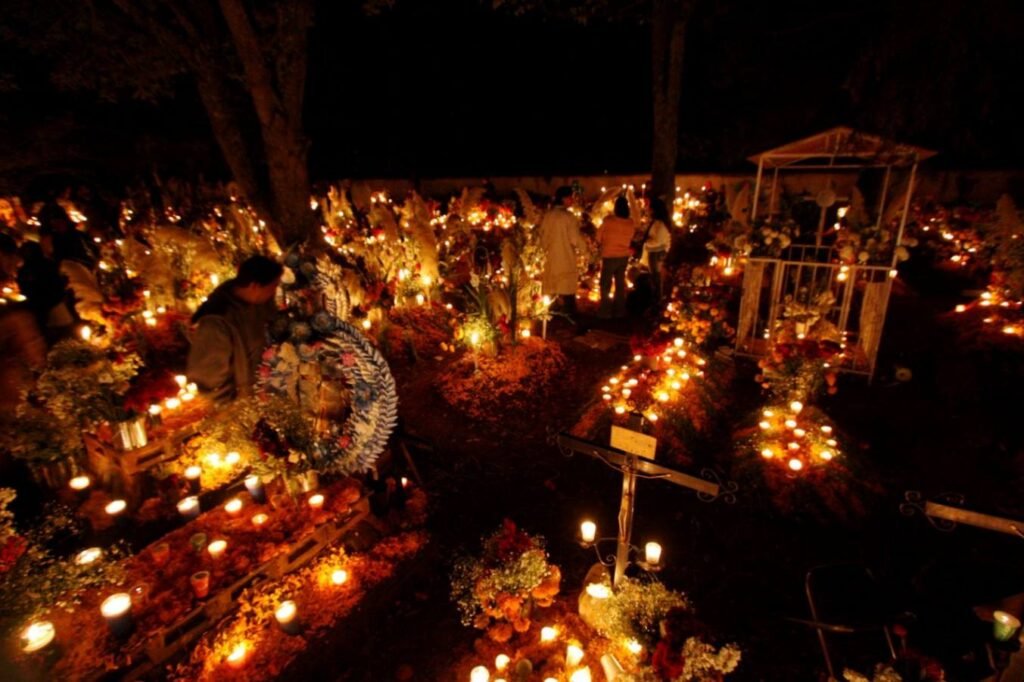
In the small town of Talca, located in the Maule Region of Chile, there exists a unique New Year’s Eve tradition. As midnight approaches on December 31st, some locals engage in a practice that might seem unusual to outsiders. They spend the night in the graveyard, keeping vigil among the tombstones.
Welcoming the New Year Amidst Memories and Love
This tradition is deeply rooted in the local culture and is a way for people to welcome the New Year in the company of their deceased loved ones. Participants bring candles, flowers, and even set up picnics beside the graves of their family members and friends. The atmosphere, contrary to what one might expect, is not morose or overly somber. Instead, it is a time of reflection, remembrance, and even celebration of the lives of those who have passed.
Celebrating the New Year Amongst Departed Loved Ones in Talca”
This practice reveals a unique view on death and the afterlife, an integral part of Talca’s cultural fabric. It celebrates the enduring connection between the living and departed, emphasizing a New Year’s welcome that includes all family members, past and present.
This singular vigil showcases the varied cultural celebrations worldwide and serves as a poignant reminder of universal themes like love, memory, and the passage of time.
Our journey through New Year’s traditions nears its end. These customs span the globe, steeped in history, and rich in mystery. They aren’t just festive acts. They’re cultural legacies, embodying our hopes, fears, and the human quest for connection and renewal as we embrace the eternal cycle of life.
In our journey through the world’s most unusual and Creepy Christmas traditions, we’ve seen how different cultures blend the festive with the fearsome, creating a rich global tapestry that celebrates the darker side of the holiday season. So, as we revel in the joy and light of Christmas, let’s not forget the intriguing allure of the shadows, in a trip to the Best Horror Festivals around the globe.
Happy New Year Folks!

